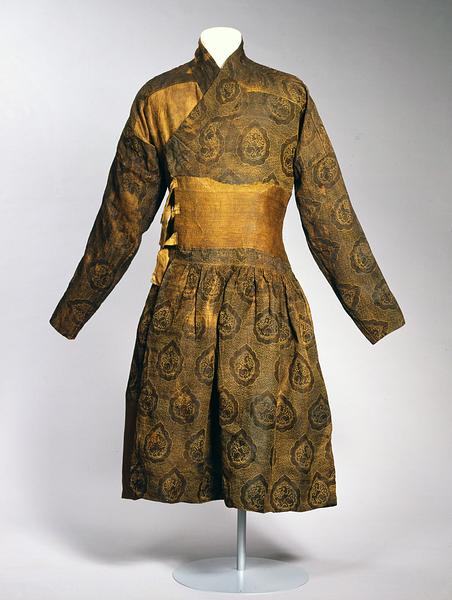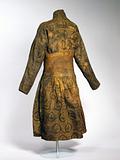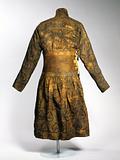Caftan sewn from a lampas-woven textile, silk with gilded lamella of animal substrate
Eastern Islamic world or China; 1st half of 14th century
H incl. collar: 139 cm; H (shoulder to hem): 130; W incl. both sleeves: 195 cm
While the typical Arab caftan was closed in the front, the Mongol was closed on the side with a row of tapes, which in this caftan are attached to a reinforced piece around the waist. The pattern demonstrates a mixture of Eastern and Western influences. The drop-shaped elements with stylized lions and surrounding swastika shapes point to China, while the stylized border with Kufi pseudo-calligraphy on the shoulders is an Islamic feature that has its origins in Arab tiraz textiles.
These textiles worked with gold were costly, and although a number of smaller parts of the same pattern were used to complete the caftan, an extra piece of another type nonetheless had to be used as well. Most of the gold has been lost, and the areas that were once golden are now brown.
Inv. no. 23/2004
Published in:
Kjeld von Folsach: “A set of silk panels from the Mongol period” in Sheila Blair and Jonathan Bloom (eds.): God is beautiful and loves beauty: the object in Islamic art and culture, New Haven 2013, p. 236, fig. 228b;
Institute of Ismaili Studies: Encounters in Muslim History, Student reader 1, London 2013, (reprint. 2017), p. 186;
Rachel Ward (ed.): Court and craft: a masterpiece from Northern Iraq, Courtauld Gallery, London 2014, fig. 29, p. 53;
Cynehild Cynesigesdohtor: Introduction to the clothing of the Silk Road cultures: or bathrobes and pajama pants for "everyone", https://medievalhomecompanion.files.wordpress.com, 2016, fig. 5;
Eiren Shea: “Textile as traveller: the transmission of inscribed robes across Asia in the twelfth through fourteenth centuries” in Arts asiatiques, 73, 2018, figs. 4 and 5, p. 32;
Patricia Blessing, Elizabeth Dospel Williams, Eiren L. Shea: Medieval textiles across Eurasia, c. 300–1400, Cambridge 2023, fig 36 and p. 44;



